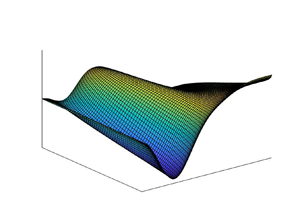Published online by Cambridge University Press: 22 February 2022

We investigate the temporal and spatio-temporal buoyancy instabilities in a horizontal liquid layer supported by a poorly conducting substrate and subjected to an oblique temperature gradient (OTG) with horizontal and vertical components, denoted as HTG and VTG, respectively. General linear stability analysis (GLSA) reveals a strong stabilizing effect of the HTG on the instabilities introduced by the VTG for Prandtl numbers  $Pr>1$ via inducing an extra vertical temperature gradient opposing the VTG through energy convection. For
$Pr>1$ via inducing an extra vertical temperature gradient opposing the VTG through energy convection. For  $Pr<1$, a new mode of instability arises as a result of a velocity jump in the liquid layer caused by cellular circulation. A long-wave weakly nonlinear evolution equation governing the spatio-temporal dynamics of the temperature perturbations is derived. Spatio-temporal stability analysis reveals the existence of a convectively unstable long-wave regime due to the HTG. Weakly nonlinear stability analysis reveals the supercritical type of bifurcation changing from pitchfork in the presence of a pure VTG to Hopf in the presence of the OTG. Numerical investigation of the spatio-temporal dynamics of the temperature disturbances in the layer in the weakly nonlinear regime reveals the emergence of travelling wave regimes propagating against the direction of the HTG and whose phase speed depends on
$Pr<1$, a new mode of instability arises as a result of a velocity jump in the liquid layer caused by cellular circulation. A long-wave weakly nonlinear evolution equation governing the spatio-temporal dynamics of the temperature perturbations is derived. Spatio-temporal stability analysis reveals the existence of a convectively unstable long-wave regime due to the HTG. Weakly nonlinear stability analysis reveals the supercritical type of bifurcation changing from pitchfork in the presence of a pure VTG to Hopf in the presence of the OTG. Numerical investigation of the spatio-temporal dynamics of the temperature disturbances in the layer in the weakly nonlinear regime reveals the emergence of travelling wave regimes propagating against the direction of the HTG and whose phase speed depends on  $Pr$. In the case of a small but non-zero Biot number, the wavelength of these travelling waves is larger than that of the fastest-growing mode obtained from GLSA.
$Pr$. In the case of a small but non-zero Biot number, the wavelength of these travelling waves is larger than that of the fastest-growing mode obtained from GLSA.